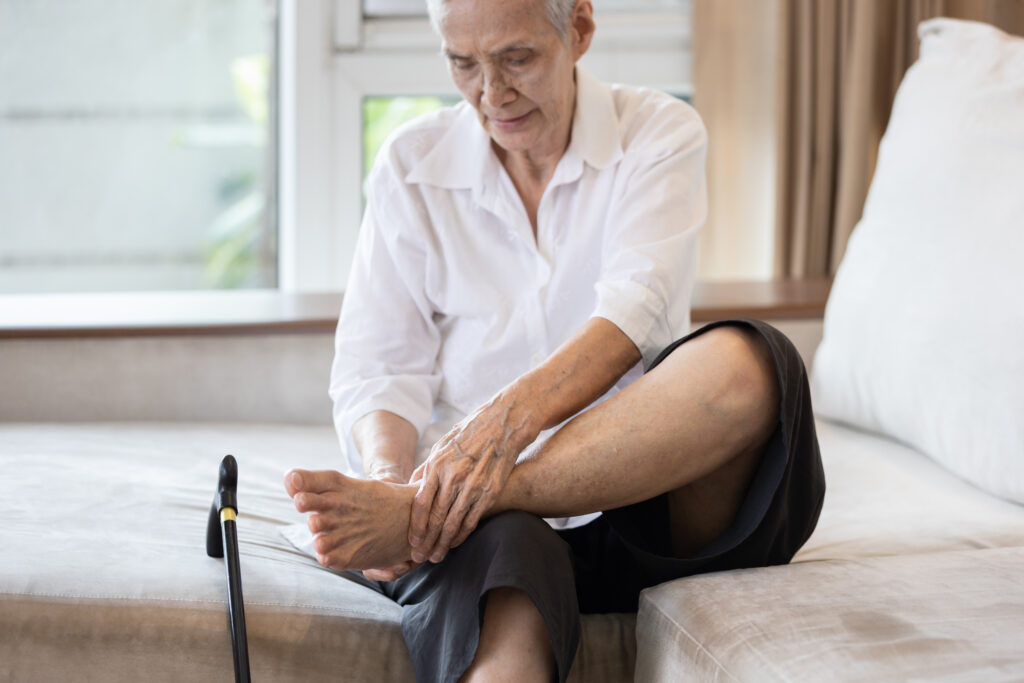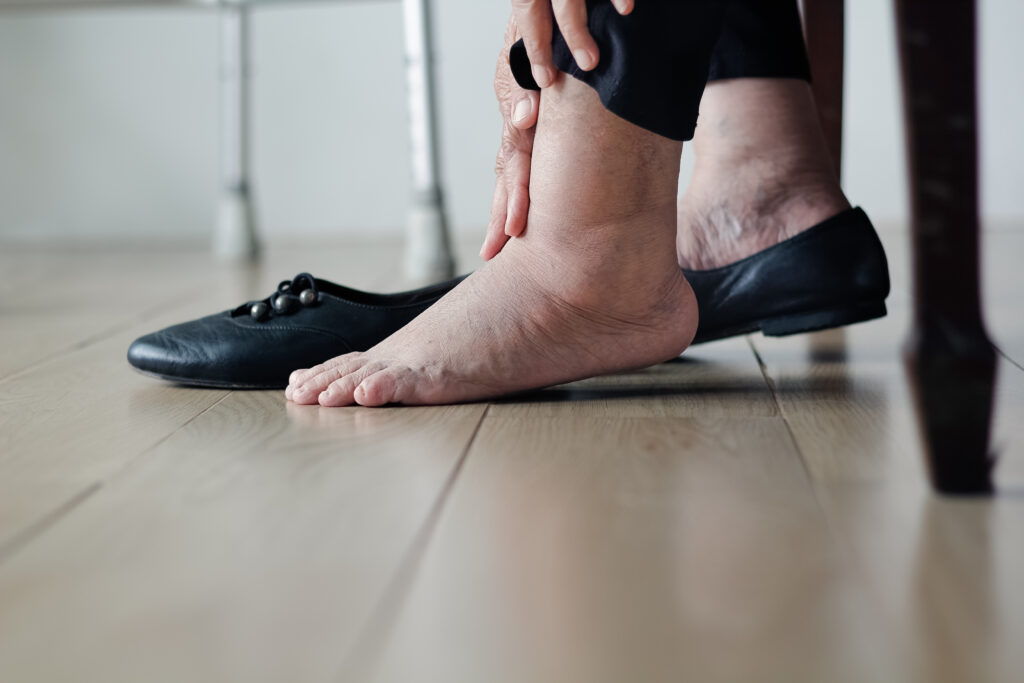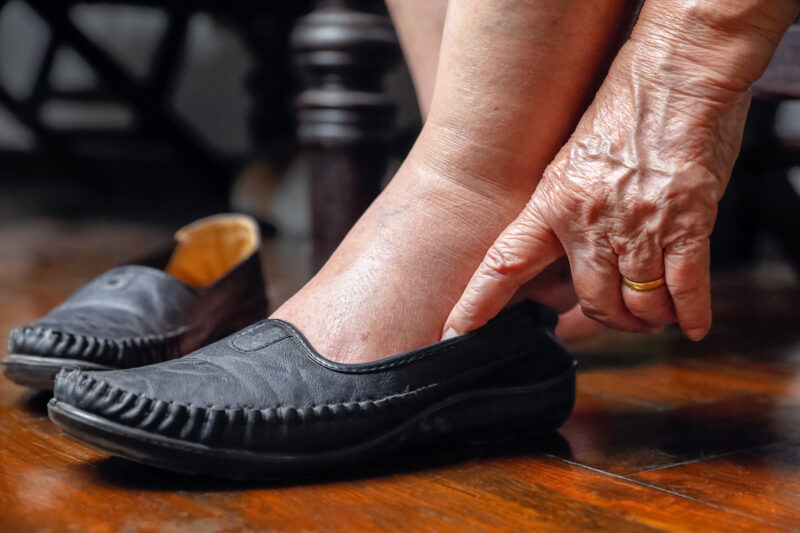Consider this: The average person walks around 7,500 steps per day. That means if a person lives to be 80, they will have walked 216,262,500 steps in their lifetime. Talk about getting your steps in!
Given the amount of work our feet do, it’s not surprising aging feet will begin to develop problems. After all, there’s only so much walking, striding, running, jumping and dancing a pair of feet can take.
According to a report from the National Institutes of Health, older people experience many foot problems, with one-third of the senior adult population dealing with at least one issue with their feet. And women are more likely to experience a medical issue than men.
Caregivers should regularly check their older loved ones’ feet for any signs of trouble, especially if they have diabetes. Trouble with feet can result in falls, infections and a host of other problems, as Dr. Neal Houslanger, a podiatrist in Patchogue, New York, told U.S News and World Report: “Our circulation diminishes, so our healing ability lessens” as we age, making older adults “more prone to infections and other issues.”
Here are some daily tips for preventing, managing and spotting foot problems in older adults.

Learn how to spot symptoms of foot problems
Spend a few minutes once a week to look at your senior’s feet. If you spot any of these symptoms, schedule a visit with a podiatrist to make sure you know what to do to take care of the problem.
Look for irregularities
- Cuts and sores: Cuts and sores on feet can get infected quickly if not kept clean.
- Blisters: These can indicate shoes are ill-fitting and may need replacing.
- Swelling: welling is of particular concern to older adults with diabetes or circulatory problems.
- Changes in color or texture to nails: Discolored toenails can indicate infection or be a result of an injury.
- Excess dryness: Dryness can cause cracking, cuts and sores.
- Sensitivity or numbness: Either of these issues can indicate a more serious health problem.
- Heel pain: Excessive pain in the heel can mean your loved one has plantar fasciitis.
Look for structural problems with feet
Feet are complicated mechanisms, with 26 bones, 30 joints and more than 100 muscles in each one. Structural changes can be painful and can cause problems with walking. Some of the most common issues for older adults include:
- Bunions: These are painful growths on the outside of the toe.
- Hammertoe: This is a deformation of the big toe that causes it to point upward.
- Calluses: This buildup of dead skin can cause a painful bump on the foot.
- Fungal infections: Keep an eye out for fungus growing between the toes or in the toenails.

Keep feet clean and dry
As people get older, flexibility and range of motion can diminish. If older adults have balance issues or other mobility challenges, picking up their legs and washing their feet will be nearly impossible. So, be sure to help your older adult keep their feet clean and make sure their feet are adequately dried to prevent fungal infections. In some religions and cultures, foot washing is considered the highest form of respect—and it can help to relax your loved one for a good night’s sleep.
Moisturize feet to keep them healthy
It’s essential to keep older feet moisturized to prevent cracking and splitting skin, resulting in infections that can quickly escalate into big problems. Use a foot cream regularly to keep your loved one’s feet soft. Good moisturizing will also reduce itching and redness if the feet are prone to irritation.
Trim the toenails
Trimming toenails may sound like simple advice, but it can be an impossible task for older adults with mobility issues and restricted movement. Don’t wait for a foot problem to develop before offering to clip your loved one’s toenails. Diligent toenail maintenance will prevent ingrown toenails or other nail infections and help keep them walking comfortably. If you prefer, treat your loved one to a pedicure once or twice a month as a special treat, or visit your podiatrist for the best toenail trimming.
Circulation needs attention
Poor circulation, which can be a result of diabetes, vascular issues or peripheral artery disease (PAD), can cause the following problems:
- Tingling
- Swelling and inflammation
- Pain, aching or heaviness
- Development of varicose veins
- Discoloration, including blue or purple feet
Elevate the feet and use warm cloths and compression socks to get the circulation going again. If this is an ongoing problem, seek medical advice.
Get the right shoes
Many seniors begin to shuffle as they age when their mobility has diminished. The less they can walk safely and comfortably on their own, the more they need the right shoes. Older adults will often gravitate toward soft, slip-on style shoes like slippers, but these options pose a substantial risk of falling because they have no support. Because falls are the leading cause of injury among older Americans – nearly 800,000 falls each year – keep your loved one in supportive, sturdy shoes to avoid mishaps.
These are some great options for shoes for older adults:
- Silverts extra-wide shoes for women and men are easy to get on and off and offer support in a sneaker-style shoe.
- Stylish and comfortable, Nike Flyease was inspired by a customer with cerebral palsy who needed an easy-on-and-off shoe that still looked like a Nike.
- DENACARE shoes offer extra depth for swelling due to edema and other foot ailments. They come in styles for men and women.
Because many older adults prefer to keep their ailments to themselves, the health of your loved one often depends on your diligence and attention to them from head to toe. Remember, staying mobile as long as possible – and getting all of those 200 million steps in – requires feet that are in the best shape they can be.

